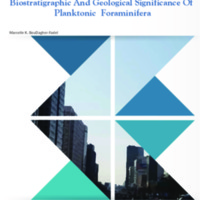Biostratigraphic And Geological Significance Of Planktonic Foraminifera
Dublin Core
Description
Foraminifera are marine, free-living, amoeboid protozoa
(in Greek, proto = first and zoa = animals). They are
single-celled eukaryotes (organisms the cytoplasm of
which is organized into a complex structure with internal
membranes and contains a nucleus, mitochondria,
chloroplasts, and Golgi bodies, see Fig. 1.1), and they
exhibit animal-like (cf. plant-like) behaviour. Usually,
they secrete an elaborate, solid carbonate skeleton (or
test) that contains the bulk of the cell, but some forms
accrete and cement tests made of sedimentary particles.
The foraminiferal test is divided into a series of chambers,
which increase in number during growth. In life, they
exhibit extra-skeletal pseudopodia (temporary organic
projections) and web-like filaments that can be granular,
branched and fused (rhizopodia), or pencil-shaped and
pointed (filopodia). The pseudopodia emerge from the
cell body (see Plate 1.1 below) and enable bidirectional
cytoplasmic flow that transports nutrients to the body of
the cell (Baldauf, 2008). Foraminifera first appeared in
the Cambrian with a benthic mode of life and, over the
course of the Phanerozoic, invaded most marginal to fully
marine environments. They diversified to exploit a wide
variety of niches, including, from the Late Triassic or
Jurassic, the planktonic realm. These planktonic forms are
the focus of this book. Both living and fossil foraminifera come in a wide
(in Greek, proto = first and zoa = animals). They are
single-celled eukaryotes (organisms the cytoplasm of
which is organized into a complex structure with internal
membranes and contains a nucleus, mitochondria,
chloroplasts, and Golgi bodies, see Fig. 1.1), and they
exhibit animal-like (cf. plant-like) behaviour. Usually,
they secrete an elaborate, solid carbonate skeleton (or
test) that contains the bulk of the cell, but some forms
accrete and cement tests made of sedimentary particles.
The foraminiferal test is divided into a series of chambers,
which increase in number during growth. In life, they
exhibit extra-skeletal pseudopodia (temporary organic
projections) and web-like filaments that can be granular,
branched and fused (rhizopodia), or pencil-shaped and
pointed (filopodia). The pseudopodia emerge from the
cell body (see Plate 1.1 below) and enable bidirectional
cytoplasmic flow that transports nutrients to the body of
the cell (Baldauf, 2008). Foraminifera first appeared in
the Cambrian with a benthic mode of life and, over the
course of the Phanerozoic, invaded most marginal to fully
marine environments. They diversified to exploit a wide
variety of niches, including, from the Late Triassic or
Jurassic, the planktonic realm. These planktonic forms are
the focus of this book. Both living and fossil foraminifera come in a wide
Creator
Source
http://discovery.ucl.ac.uk/1404017/15/9781910634264_OnlinePDF.pdf
Publisher
Contributor
Rahmah Agustira
Rights
Creative Commons
Format
Textbooks
Type
Files
Collection
Citation
Marcelle K. Boudagher-Fadel, “Biostratigraphic And Geological Significance Of Planktonic Foraminifera
,” Open Educational Resources (OER) , accessed December 7, 2025, https://oer.uinsyahada.ac.id/items/show/239.


